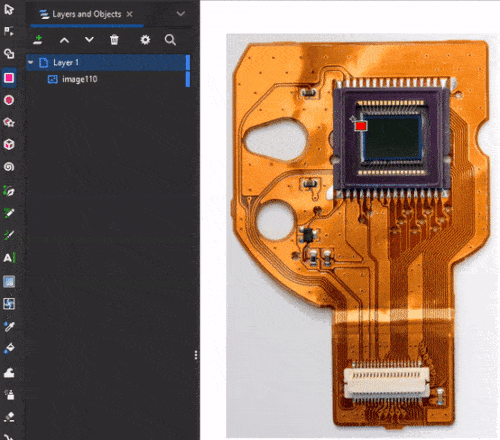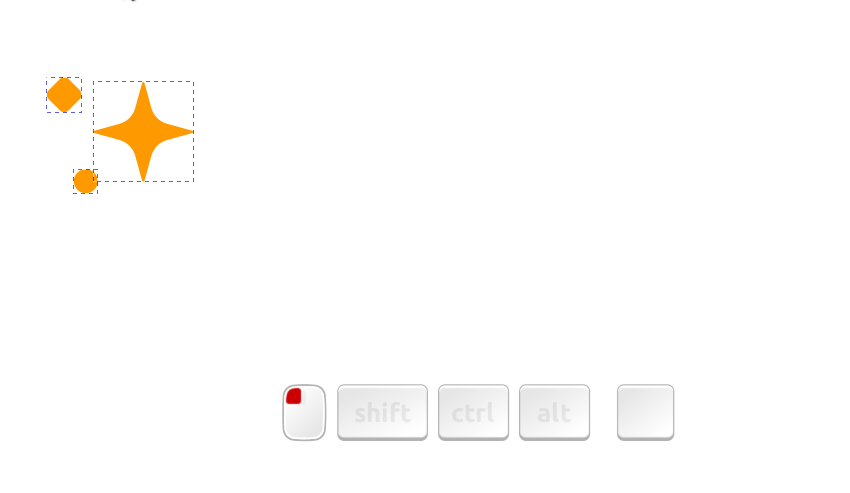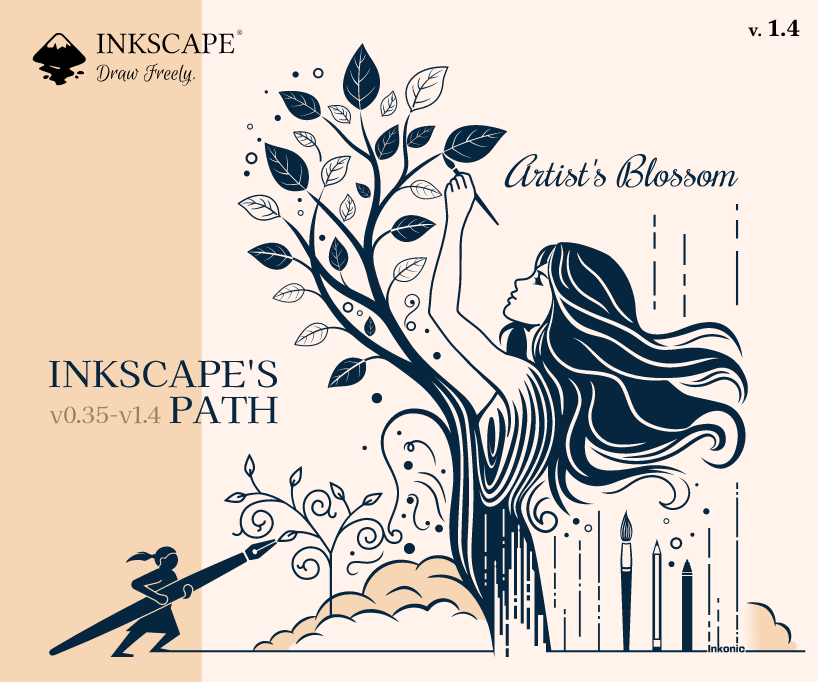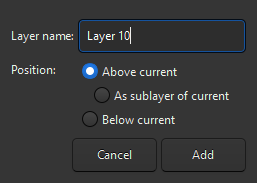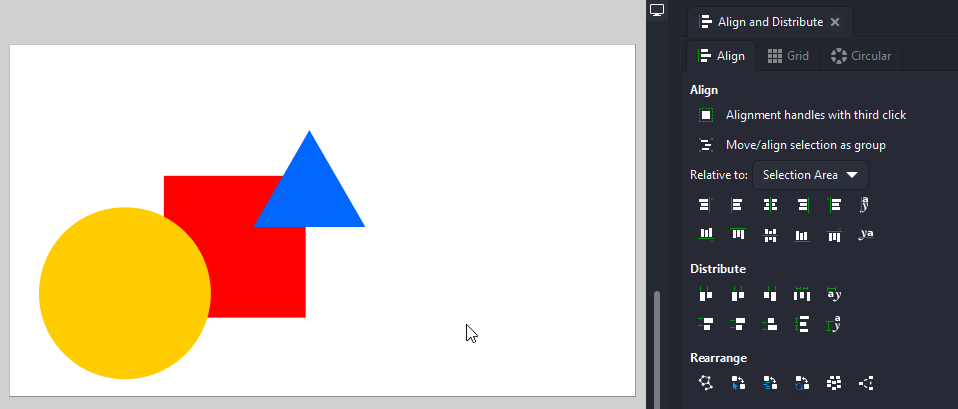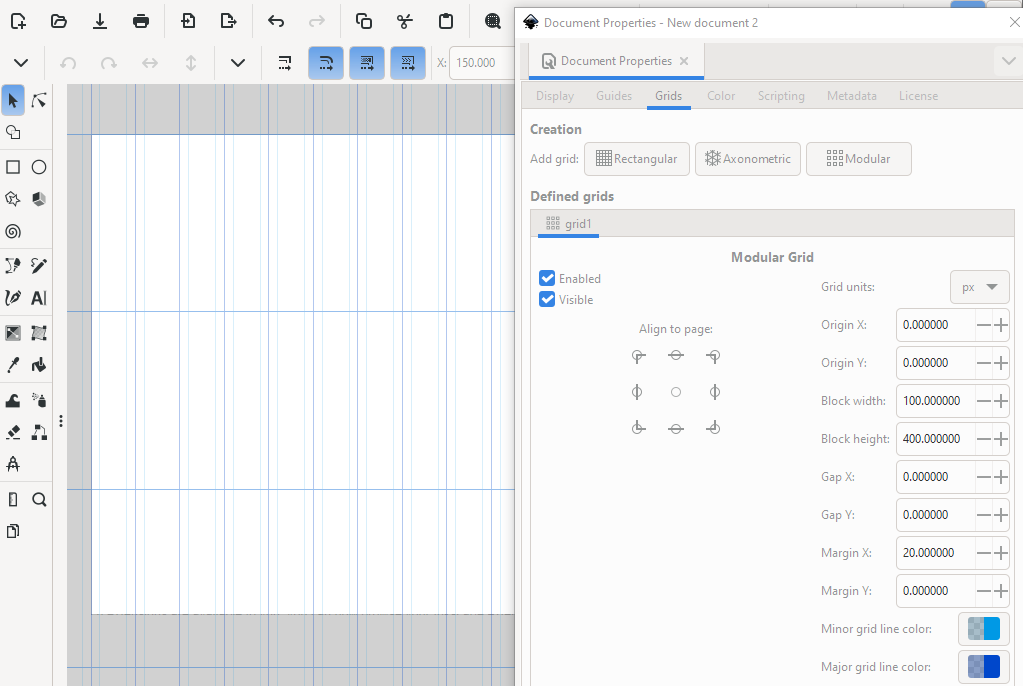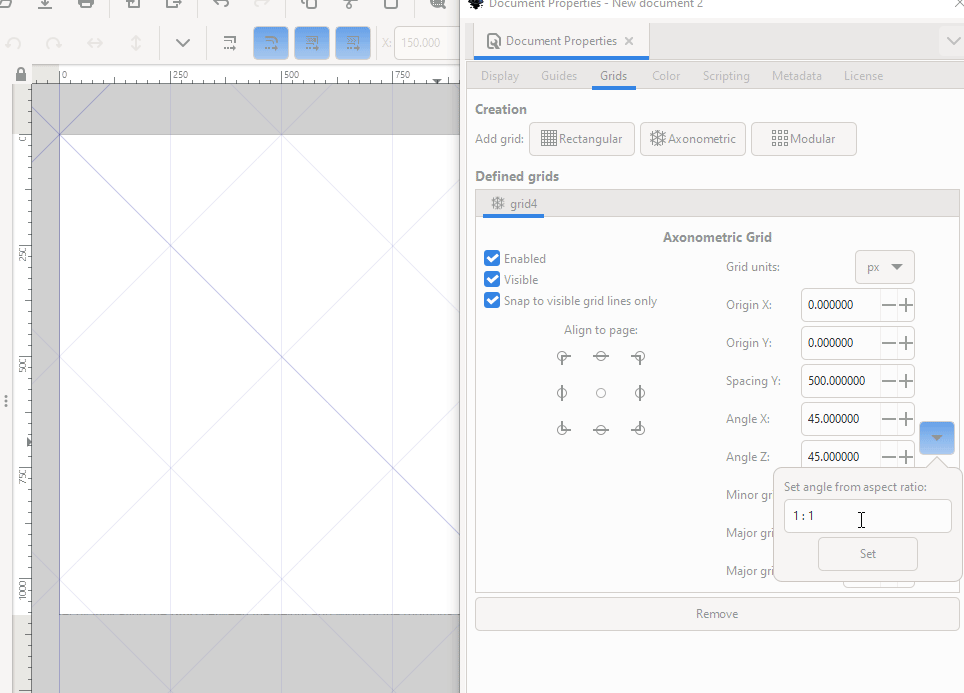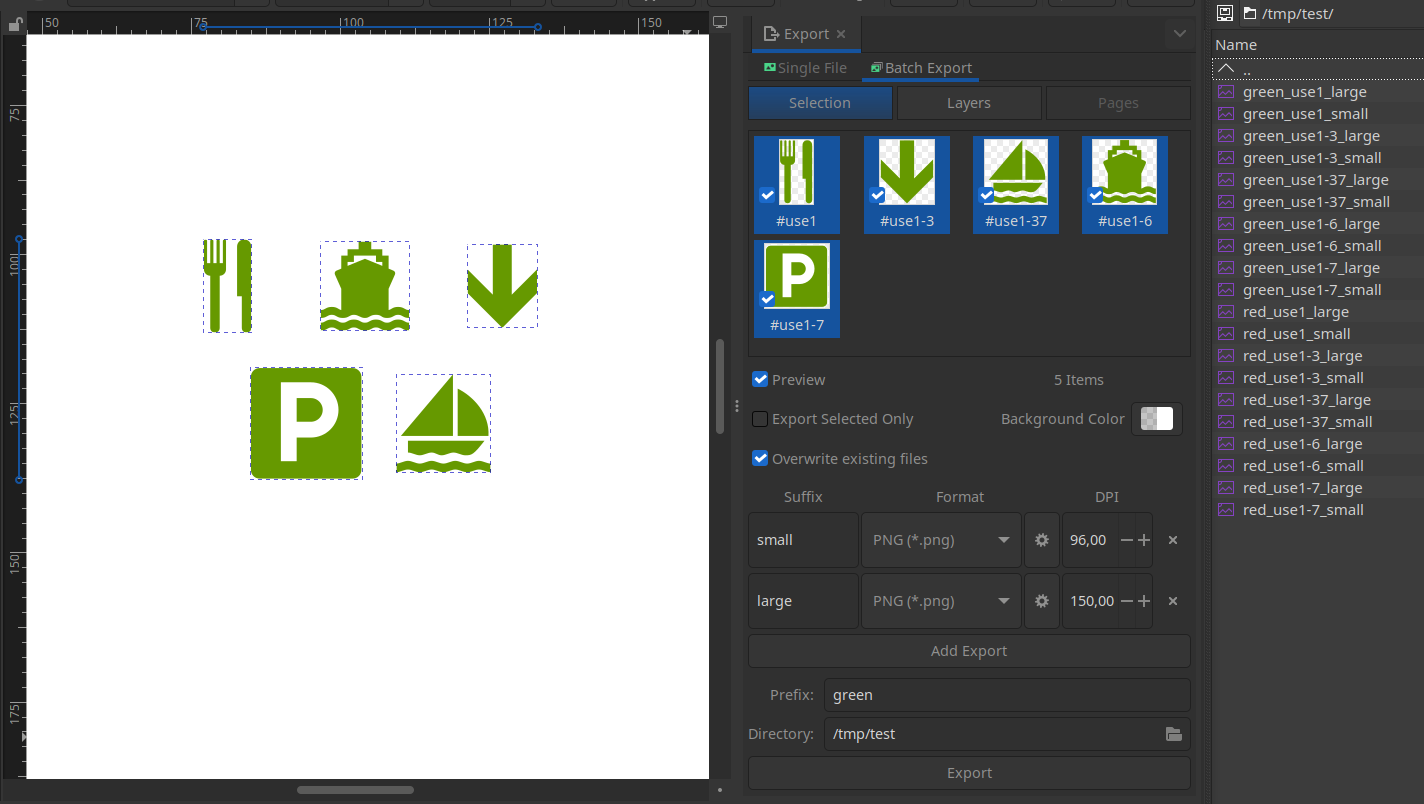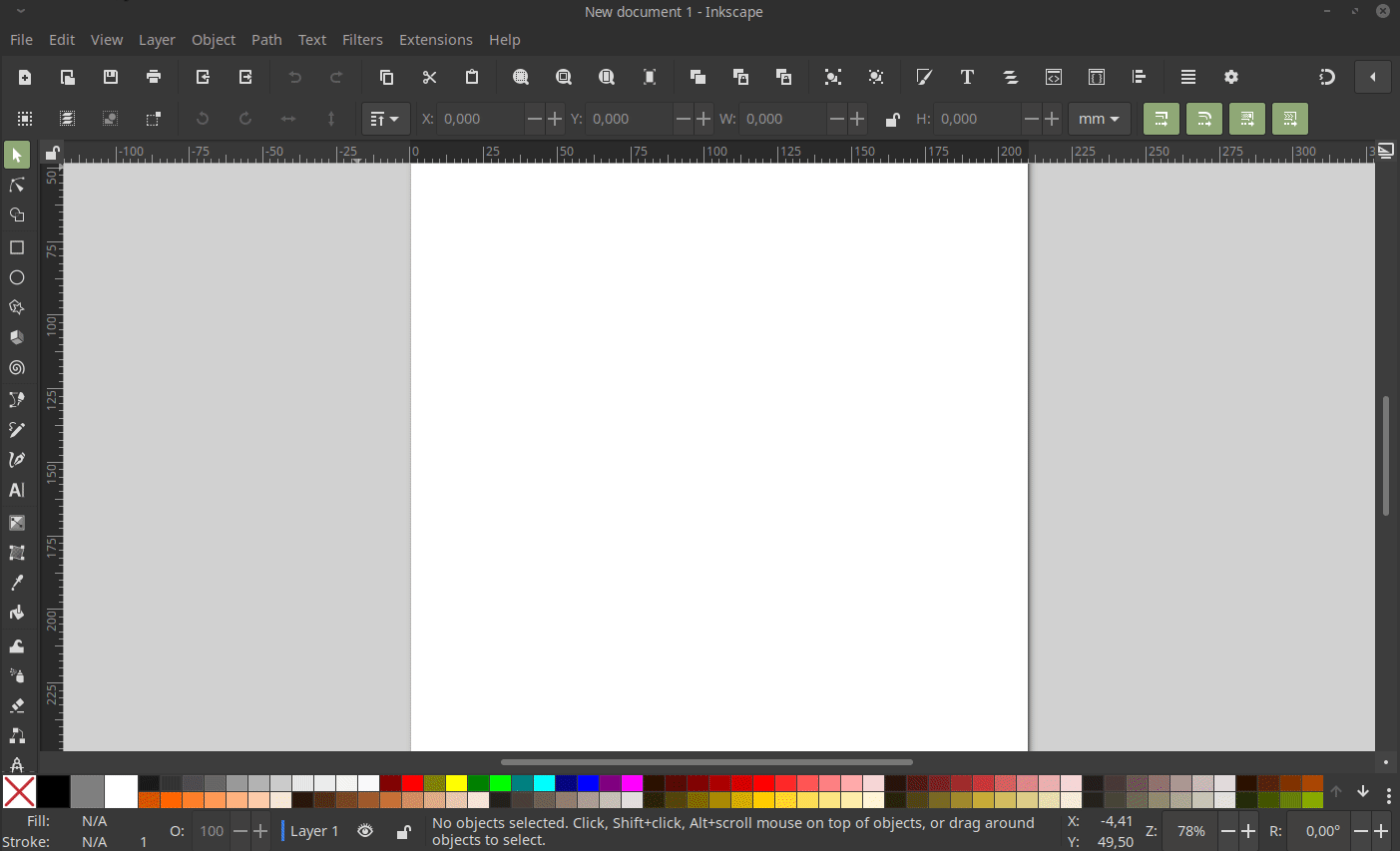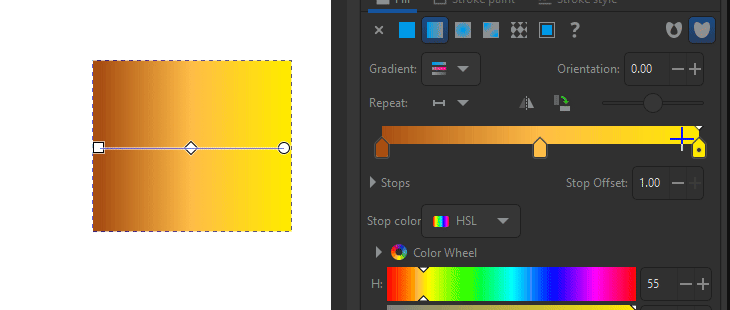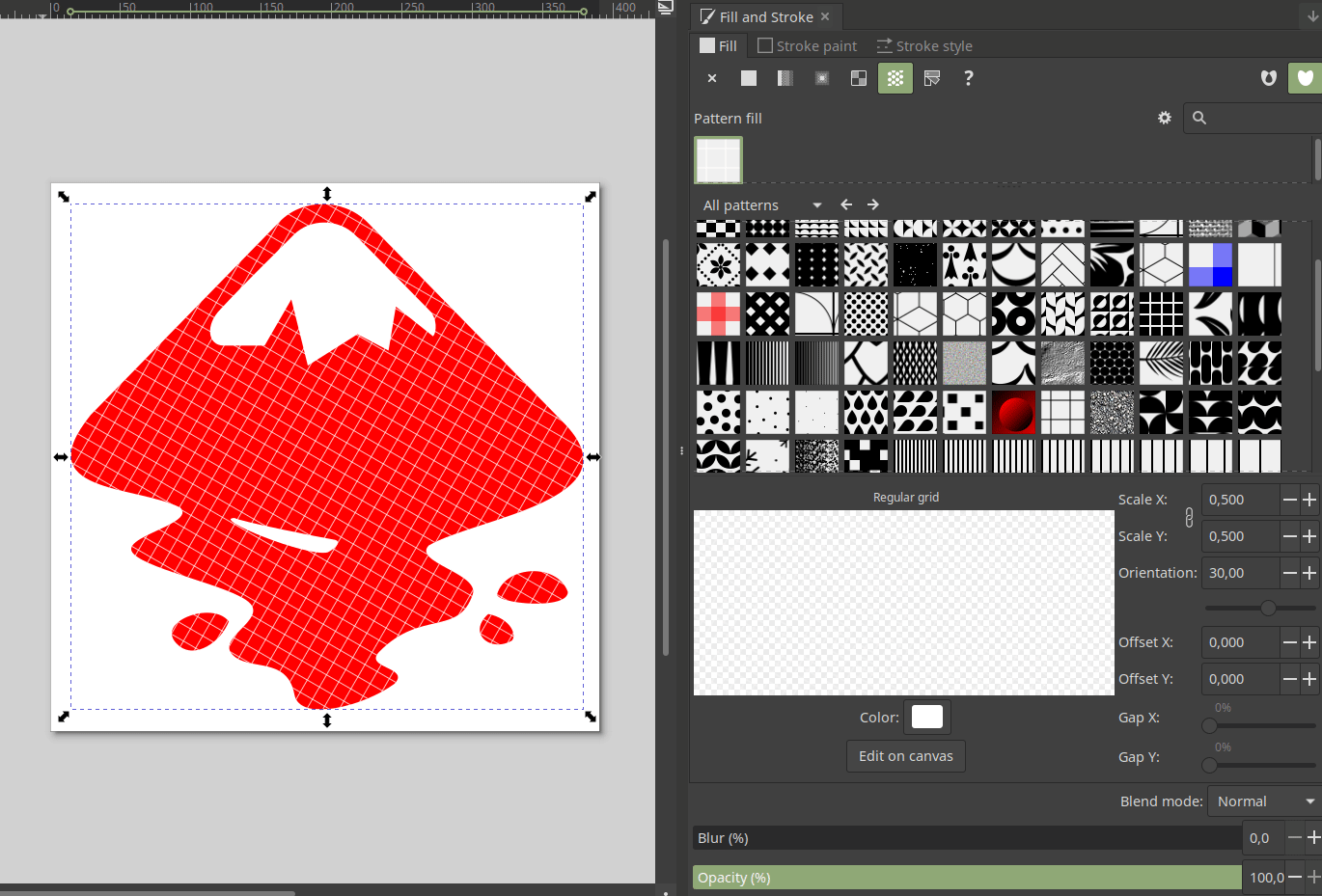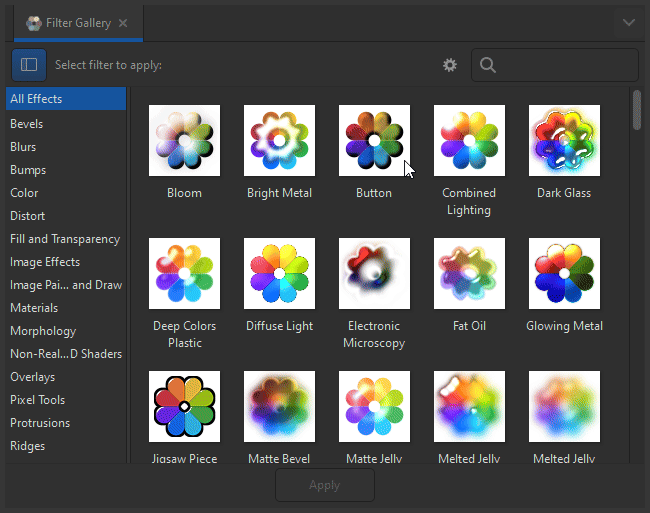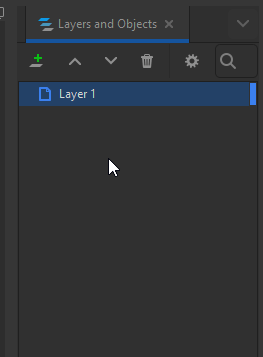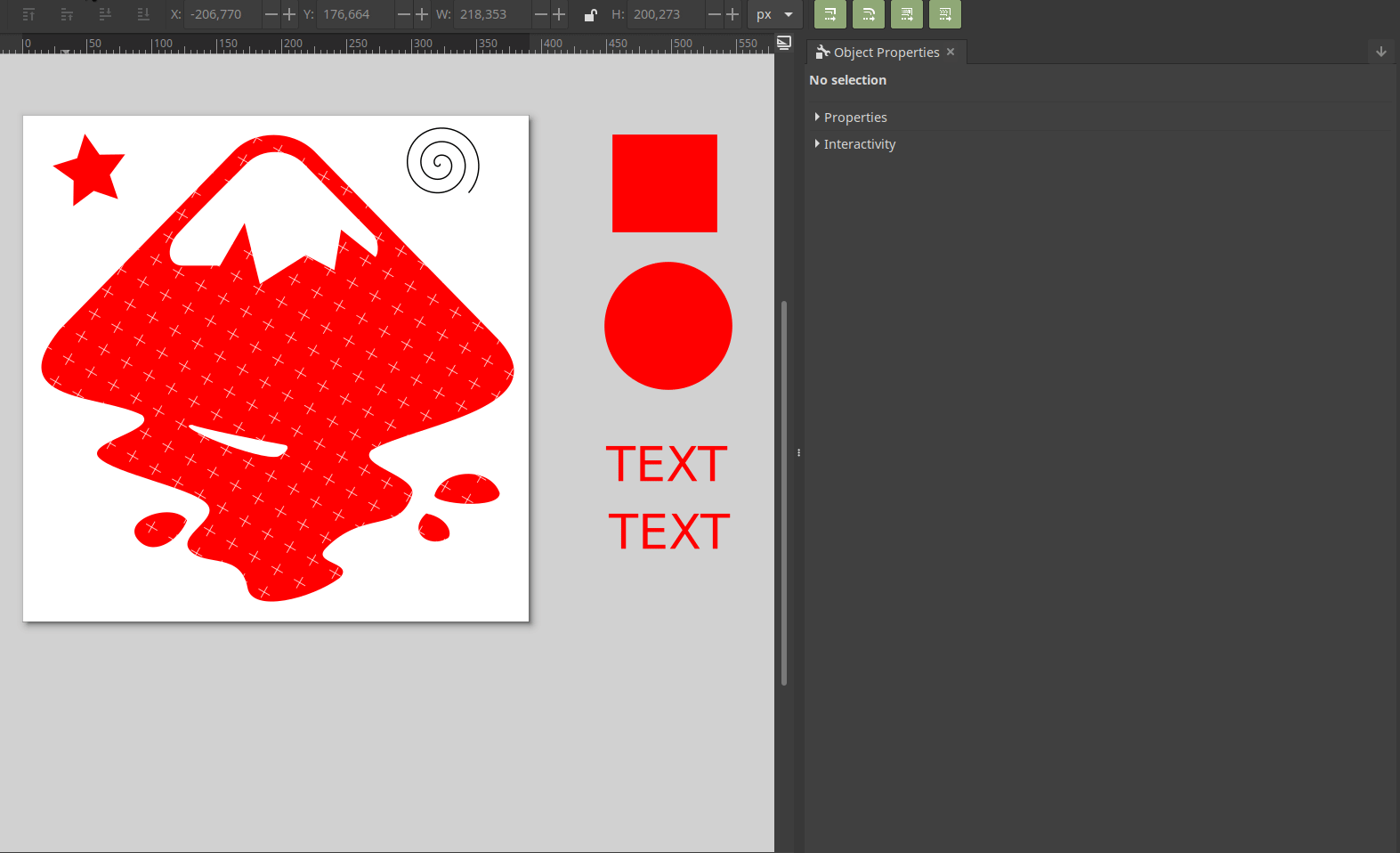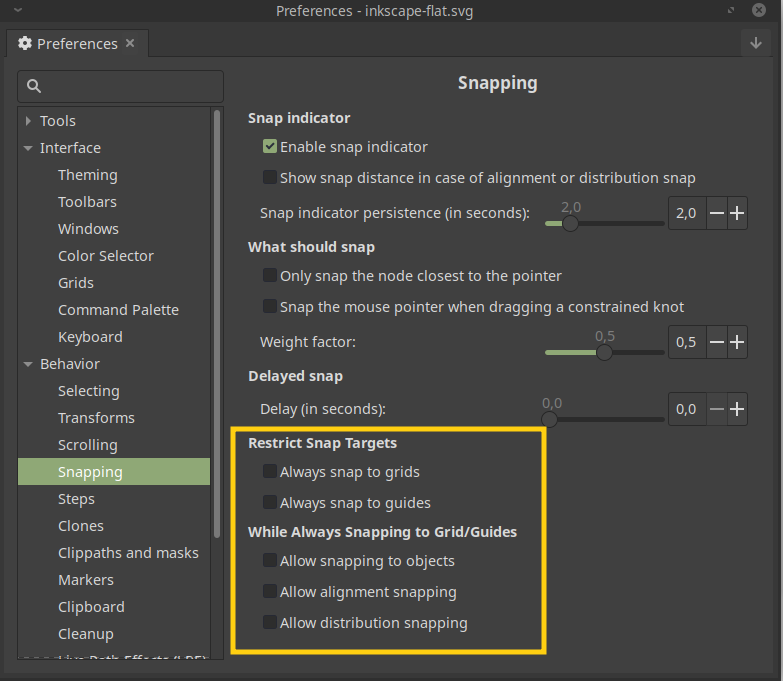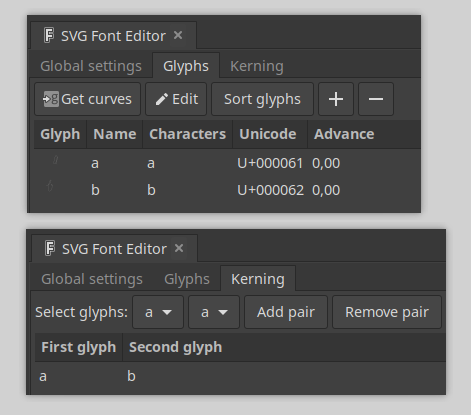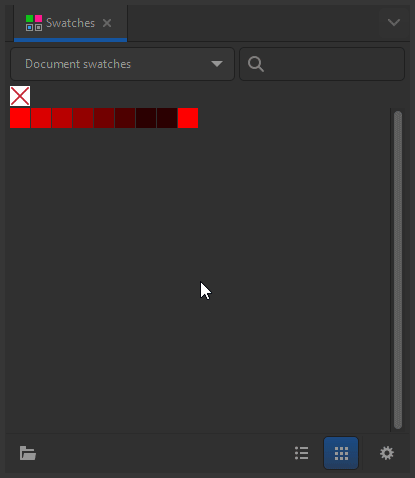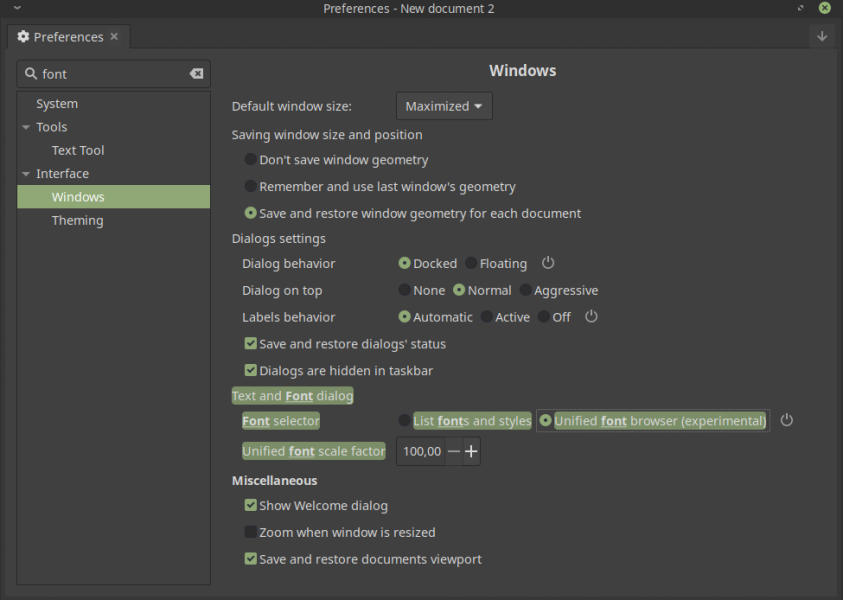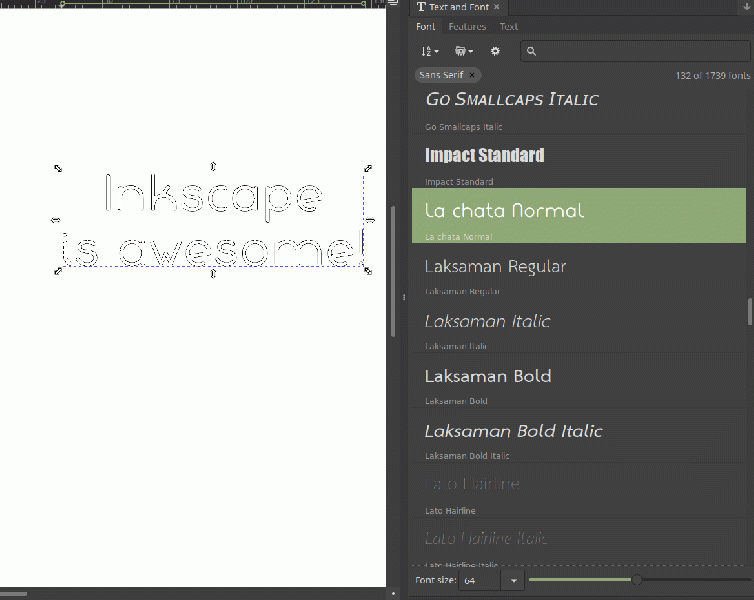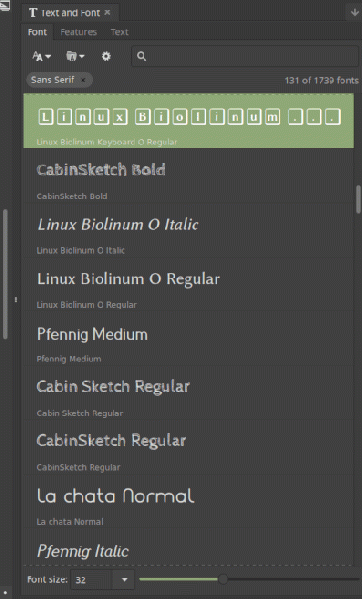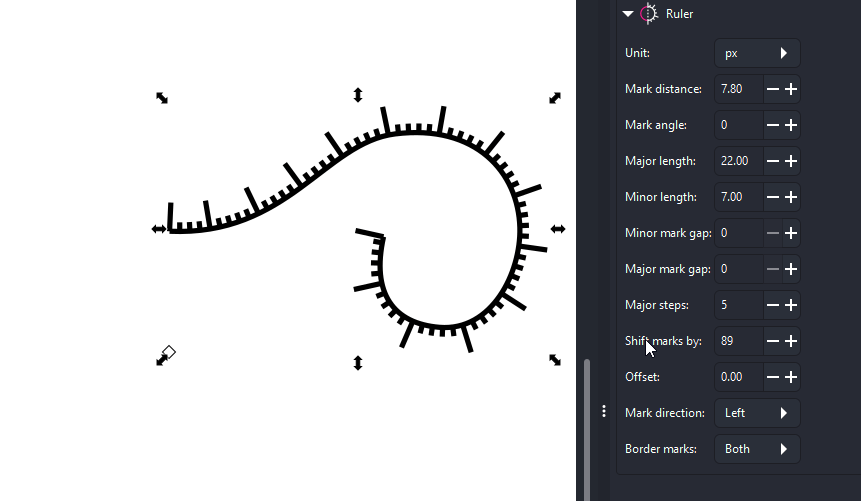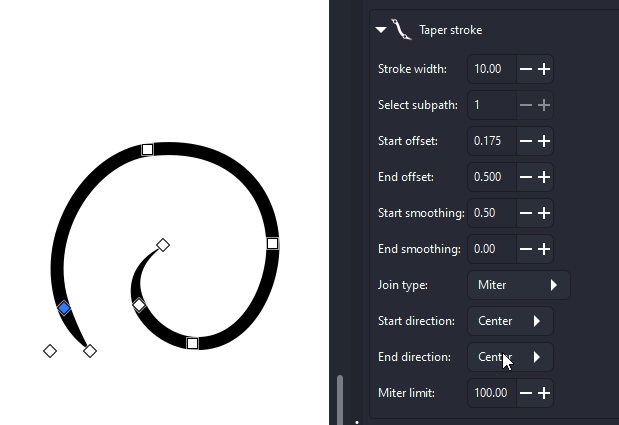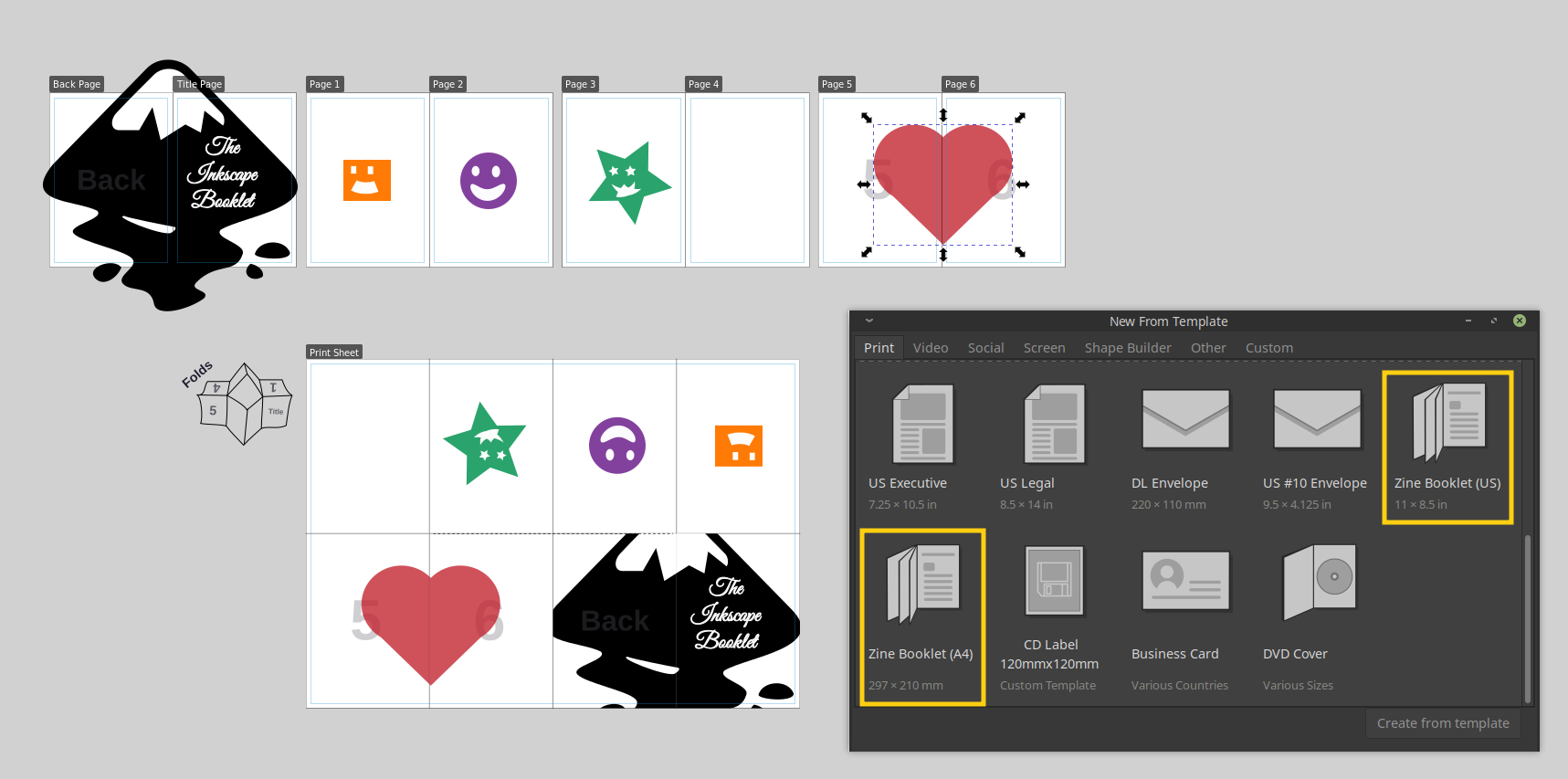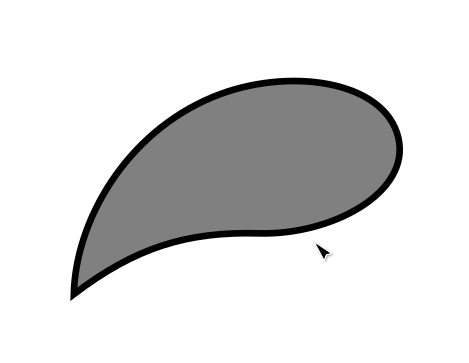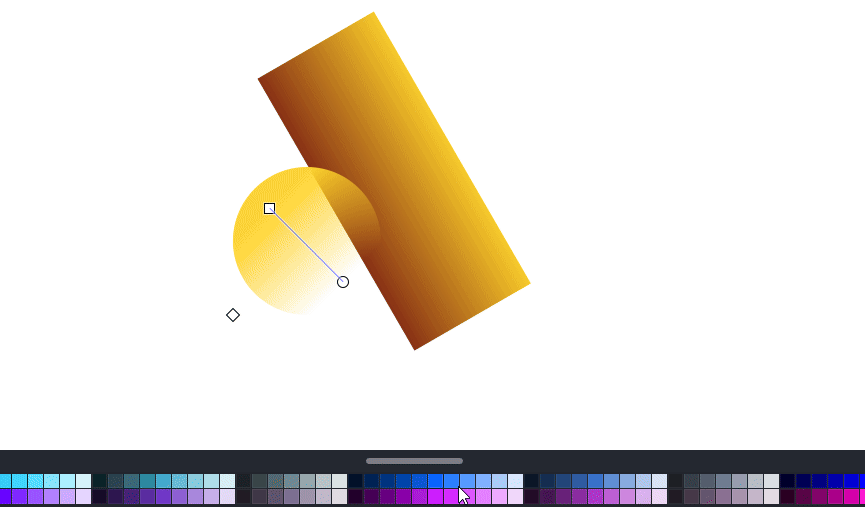Difference between revisions of "Release notes/1.4"
(More formatting.) |
(Format menu paths.) |
||
| Line 53: | Line 53: | ||
* The mouse/keyboard shortcut for '''converting a curved path segment to a straight line''' has been changed from <kbd>Ctrl+Click</kbd> to <kbd>Alt+Double-click</kbd> as a fix to the double-click action of the 'delete segment' command not being recognized correctly ([https://gitlab.com/inkscape/inkscape/-/issues/4984 Bug #4984], [https://gitlab.com/inkscape/inkscape/-/merge_requests/6504 MR #6504]). | * The mouse/keyboard shortcut for '''converting a curved path segment to a straight line''' has been changed from <kbd>Ctrl+Click</kbd> to <kbd>Alt+Double-click</kbd> as a fix to the double-click action of the 'delete segment' command not being recognized correctly ([https://gitlab.com/inkscape/inkscape/-/issues/4984 Bug #4984], [https://gitlab.com/inkscape/inkscape/-/merge_requests/6504 MR #6504]). | ||
* '''Deleting a node''' now behaves differently again ([https://gitlab.com/inkscape/inkscape/-/issues/4984 Bug #4984], [https://gitlab.com/inkscape/inkscape/-/merge_requests/6285 MR #6285], [https://gitlab.com/inkscape/inkscape/-/merge_requests/6635 MR #6635]). With the preference option <code>Edit | * '''Deleting a node''' now behaves differently again ([https://gitlab.com/inkscape/inkscape/-/issues/4984 Bug #4984], [https://gitlab.com/inkscape/inkscape/-/merge_requests/6285 MR #6285], [https://gitlab.com/inkscape/inkscape/-/merge_requests/6635 MR #6635]). With the preference option <code>Edit ➞ Preferences ➞ Node tool: Deleting node preserves shape</code> active, Inkscape will use its node sharpness autodetection to decide whether the shape will be kept, or the node will be removed without adjusting the adjacent nodes' handles. With the option inactive, Inkscape will behave like Inkscape 1.2 (no autodetection, shape is kept when pressing <kbd>Del</kbd>, straight lines with <kbd>Ctrl + Del</kbd>). | ||
{| class="wikitable" | {| class="wikitable" | ||
| Line 79: | Line 79: | ||
=== Selector Tool & Node Tool === | === Selector Tool & Node Tool === | ||
* In <code>Edit | * In <code>Edit ➞ Preferences ➞ Behavior ➞ Steps</code>, an option has been added to change how '''moving selected objects / nodes with the arrow''' keys works '''when the canvas is rotated''' (Arrow keys move object relative to screen). If you're working with a rotated canvas, now, by default, the arrow keys will move the selection horizontally and vertically relative to the screen, not to the rotated document. This allows to work more intuitively while the canvas is rotated. Disabling the option will restore the previous behavior ([https://gitlab.com/inkscape/inkscape/-/merge_requests/5031 MR #5031]). | ||
* In the preferences settings for both tools, '''options for changing the active layer and active page''' when using the tool to select an object have been added. The Selector tool will change both active layer and active page, while the Node tool will change neither, by default. Other tools (Text tool, Rectangle tool, …) do not change either layer or page when being used (but they can, if you edit the <code>preferences.xml</code> file in a text editor, [https://gitlab.com/inkscape/inkscape/-/merge_requests/5257 MR #5257]). | * In the preferences settings for both tools, '''options for changing the active layer and active page''' when using the tool to select an object have been added. The Selector tool will change both active layer and active page, while the Node tool will change neither, by default. Other tools (Text tool, Rectangle tool, …) do not change either layer or page when being used (but they can, if you edit the <code>preferences.xml</code> file in a text editor, [https://gitlab.com/inkscape/inkscape/-/merge_requests/5257 MR #5257]). | ||
| Line 242: | Line 242: | ||
==== Snapping ==== | ==== Snapping ==== | ||
More options for '''finetuning snapping precedence''' between '''grid and guidelines vs. objects and alignment/distribution''' have been added at <code>Edit | More options for '''finetuning snapping precedence''' between '''grid and guidelines vs. objects and alignment/distribution''' have been added at <code>Edit ➞ Preferences ➞ Behavior ➞ Snapping</code>. | ||
These allow you to set grids and / or guidelines as the only available snap target, and to add more snap targets incrementally. | These allow you to set grids and / or guidelines as the only available snap target, and to add more snap targets incrementally. | ||
| Line 277: | Line 277: | ||
==== Experimental Alternative User Interface ==== | ==== Experimental Alternative User Interface ==== | ||
An experimental <code>Unified font browser</code> has been added. If it is activated under <code>Edit | An experimental <code>Unified font browser</code> has been added. If it is activated under <code>Edit ➞ Preferences ➞ Interface ➞ Dialogs : Text and Font dialog</code> (requires restart), it will replace the <code>Text and Font</code> dialog with a '''sortable, filterable, searchable and adjustable list''' of font previews. | ||
Any font you select '''will be applied immediately'''. The <code>Font Attributes</code> tab and <code>Text</code> tab are available, too ([https://gitlab.com/inkscape/inkscape/-/merge_requests/4578 MR #4578]). | Any font you select '''will be applied immediately'''. The <code>Font Attributes</code> tab and <code>Text</code> tab are available, too ([https://gitlab.com/inkscape/inkscape/-/merge_requests/4578 MR #4578]). | ||
| Line 289: | Line 289: | ||
* '''preview text contents''' (choice between some presets, custom text entry for the long (row view) sample and the short (grid view) sample) | * '''preview text contents''' (choice between some presets, custom text entry for the long (row view) sample and the short (grid view) sample) | ||
* whether to show the '''font name''' below the preview | * whether to show the '''font name''' below the preview | ||
* in the global Inkscape preferences (<code>Edit | * in the global Inkscape preferences (<code>Edit ➞ Preferences ➞ Interface ➞ Windows ➞ Text and Font dialog: Unified font scale factor</code>), the '''height of the preview lines''' can be adjusted, as in some cases, fonts look cut off in the list preview. | ||
<gallery mode="packed" heights=400px> | <gallery mode="packed" heights=400px> | ||
| Line 351: | Line 351: | ||
* The shortcuts for <code>Quick Preview</code> (<kbd>F</kbd>), <code>Quick Zoom</code> (<kbd>Q</kbd>), panning (<kbd>Space</kbd>), <code>Pen Segment To Line</code> (<kbd>Shift + L</kbd>), <code>Pen Segment To Curve</code> (<kbd>Shift + U</kbd>) and <code>Pen Segments To Guides</code> (<kbd>Shift + G</kbd>) are now customizable ([https://gitlab.com/inkscape/inkscape/-/merge_requests/6308 MR #6308]). | * The shortcuts for <code>Quick Preview</code> (<kbd>F</kbd>), <code>Quick Zoom</code> (<kbd>Q</kbd>), panning (<kbd>Space</kbd>), <code>Pen Segment To Line</code> (<kbd>Shift + L</kbd>), <code>Pen Segment To Curve</code> (<kbd>Shift + U</kbd>) and <code>Pen Segments To Guides</code> (<kbd>Shift + G</kbd>) are now customizable ([https://gitlab.com/inkscape/inkscape/-/merge_requests/6308 MR #6308]). | ||
* The macOS-specific <code>carbon.xml</code> keyboard shortcuts file has been '''removed''', as it hasn't been kept up to date for years ([https://gitlab.com/inkscape/inkscape/-/merge_requests/6522 MR #6522]). | * The macOS-specific <code>carbon.xml</code> keyboard shortcuts file has been '''removed''', as it hasn't been kept up to date for years ([https://gitlab.com/inkscape/inkscape/-/merge_requests/6522 MR #6522]). | ||
* Some existing commands that did not have a default shortcut '''now have one'''. Note that these will '''only be available''' to you if you '''install Inkscape for the first time''', not when upgrading an existing installation. In that case, you can set these manually in <code>Edit | * Some existing commands that did not have a default shortcut '''now have one'''. Note that these will '''only be available''' to you if you '''install Inkscape for the first time''', not when upgrading an existing installation. In that case, you can set these manually in <code>Edit ➞ Preferences ➞ Interface ➞ Keyboard</code>, or you can reset your keyboard shortcuts by replacing the file <code>default.xml</code> in your Inkscape user configuration director with a copy of the file <code>inkscape.xml</code> from the <code>keys</code> directory of your Inkscape installation's <code>share</code> directory ([https://gitlab.com/inkscape/inkscape/-/merge_requests/6462 MR #6462]): | ||
{| class="wikitable" | {| class="wikitable" | ||
| Line 379: | Line 379: | ||
In addition to the new import formats for <code>*.afdesign</code> and <code>*.cgm</code> files, which are implemented via the extensions subsystem, | In addition to the new import formats for <code>*.afdesign</code> and <code>*.cgm</code> files, which are implemented via the extensions subsystem, | ||
* the <code>typst formula</code> extension (<code>Extensions | * the <code>typst formula</code> extension (<code>Extensions ➞ Text ➞ Formula (typst)</code> converts [https://typst.app typst] math markup into a path, and surving a similar purpose as the LaTeX extension ([https://gitlab.com/inkscape/extensions/-/merge_requests/606 MR extensions#606]). | ||
==== Improvements ==== | ==== Improvements ==== | ||
Revision as of 20:37, 4 October 2024

|
These Release Notes are in Draft Status.
Note: Not all animations work, due to Wiki bugs with resizing images. Release notes will be transferred to website, there animations will be working. Important Links:
|

|
Pending questions:
|
Release highlights
- Filter Gallery: it has never been so easy to find the best filter for your needs! This new dialog features previews, categories and search.
- Modular grids & improved axonometric grids: set the grid angle by ratio for isometric designs and use modular grids to plan layouts and make icons!
- Swatches dialog and palette file handling improved: quick access to dialog layout controls, search for colors, and open different palette file formats!
- Unified font browser preview: when activated in the preferences, use it to quickly browse through your font collection. Try it out and give your feedback!
- Customizable handles: Power users with CSS knowledge can now customize the styling and basic shape of all the handles!
- Fast image clipping with the Shape Builder: raster graphics can now be clipped into multiple sections using the Shape Builder.
- There's even more: new templates for folding booklets, additional options in Ruler and Taper Stroke LPE, new keyboard shortcuts, changed node deletion behavior, preview in Spray tool, many new command line options, more supported color palette formats, updated translations and many bug fixes.
Canvas
Guides
When creating a new guide, all guides are now unlocked, so the new guide can be moved and adjusted freely (MR #5814).
Tools
General
Toolbars now try to make use of the available space by not hiding options in dropdown menus when there's enough space. Instead, they are sorted into multiple dropdown menus, when the window is shrunk or there is not enough space.
Previously, any options that did not fit went into the same small arrow dropdown at the end of the toolbar and were hard to discover.
The change also leads to a larger minimal width of the Inkscape window, which is now dependent upon the selected tool with its collapsed toolbar items.
Node Tool
- The mouse/keyboard shortcut for converting a curved path segment to a straight line has been changed from Ctrl+Click to Alt+Double-click as a fix to the double-click action of the 'delete segment' command not being recognized correctly (Bug #4984, MR #6504).
- Deleting a node now behaves differently again (Bug #4984, MR #6285, MR #6635). With the preference option
Edit ➞ Preferences ➞ Node tool: Deleting node preserves shapeactive, Inkscape will use its node sharpness autodetection to decide whether the shape will be kept, or the node will be removed without adjusting the adjacent nodes' handles. With the option inactive, Inkscape will behave like Inkscape 1.2 (no autodetection, shape is kept when pressing Del, straight lines with Ctrl + Del).
| Keys pressed | Curve is (almost) cusp | Curve is smooth |
|---|---|---|
| Del + Preference for keeping shape is active (default) | Adjacent handles will not be adjusted | Adjacent handles will be adjusted to try and keep the shape |
| Ctrl + Del + Preference for keeping shape is active | Adjacent handles will be retracted, producing a straight line | Adjacent handles will be retracted, producing a straight line |
| Del + Preference for keeping shape is not active (pre-1.3 behavior) | Adjacent handles will be adjusted to try and keep the shape | Adjacent handles will be adjusted to try and keep the shape |
| Ctrl + Del + Preference for keeping shape is not active | Adjacent handles will be retracted, producing a straight line | Adjacent handles will be retracted, producing a straight line |
Pen Tool
A new option has been added to automatically convert the currently drawn shape to guides, allowing users to 'draw' guides instead of dragging them out of the rulers. It comes without a keyboard shortcut, but you can set one in the preferences (MR #6308).
Rectangle Tool
A new mode to only draw squares with Alt + Ctrl has been added to the tool (MR #6199).
Selector Tool & Node Tool
- In
Edit ➞ Preferences ➞ Behavior ➞ Steps, an option has been added to change how moving selected objects / nodes with the arrow keys works when the canvas is rotated (Arrow keys move object relative to screen). If you're working with a rotated canvas, now, by default, the arrow keys will move the selection horizontally and vertically relative to the screen, not to the rotated document. This allows to work more intuitively while the canvas is rotated. Disabling the option will restore the previous behavior (MR #5031). - In the preferences settings for both tools, options for changing the active layer and active page when using the tool to select an object have been added. The Selector tool will change both active layer and active page, while the Node tool will change neither, by default. Other tools (Text tool, Rectangle tool, …) do not change either layer or page when being used (but they can, if you edit the
preferences.xmlfile in a text editor, MR #5257).
Shape Builder Tool
Several improvements were made to the Shape Builder (MR #5428):
- The Shape Builder tool can now make use of raster graphics, too. Any paths selected together with a raster (pixel) graphic will now function as clipping paths, their colors are not preserved - unlike when you have only paths in the selection. The resulting image parts use clipped clones of the image, to keep the file size small and improve performance. If you want to edit them, you need to unlink the clones.
- An option for the transparency level of the original drawing has been added (the eye icon opens a popup slider).
- Optionally, it is now possible to keep a copy of the original objects after the Shape Builder's operation. This option is deactivated by default.
Spray Tool
- The Spray Tool now shows an outline preview of the next item that it is going to spray, including its shape, rotation and size. The preview is only visible when the tool is not currently spraying. That way, you can choose where to place the next item (with a single click instead of holding the mouse button down). It is possible to change the previewed (soon-to-be-sprayed) item by right-clicking and then moving the mouse by a tiny amount (MR #5375).
- The option to only spray non-overlapping objects now yields faster results through an updated spraying algorithm (MR #5766).
Import / Export
New Import Formats
Affinity Designer File Import
An importer for the native file format of Affinity Designer (*.afdesign) was added as Manpreet Singh's Google Summer of Code project (project report). Since there is no official documentation for this format available, consider this a best-effort implementation. Please report any files that don't import properly.
Computer Graphics Metafaile
An importer for CGM (Computer Graphics Metafile) was added. Support for this old, but ISO-standardized file format had been removed with Inkscape 1.0, but it is back for you now (MR extensions#638)!
PDF Export
PDF export now supports internal links (going from one part of the file to another part of the same file, weblinks were supported since Inkscape 1.0). This can be used for creating Tables of Contents, for example (MR #5237).
Dialogs
About Inkscape
- Inkscape's new About Screen is Inkonic's "Inkscape's Path–Artist's Blossom".
- The About Screen dialog now has the ability to display multiple drawings as a slideshow (MR #5559).
- The dialog can now be closed by pressing Esc (MR #5860).
Add Layer
The Add Layer dialog now shows the three available options all written out directly as radio buttons, instead of hiding them behind a drop-down selection (MR #5074).
Align and Distribute
The alignment options field Relative to now hides irrelevant options when only a single item is selected, with Page being the default (MR #6510).
Create Anchor (Hyperlink) / Object Properties
To make it easier to select an element in the drawing to link to, a button has been added to the side of the field where the target object's id or the external link must be inserted (Href).
When you click on that button, your mouse cursor will transform into a little hand icon. When the hand hovers over any object or over an empty area of the page, a small indicator text will tell you the id of that object or page. Clicking on the object will automatically insert that object's id into the href field. That way, you do not need to use the Objects or XML dialog to look up the internal identifier of the object you want to link to (MR #5221)
Document properties
Scale lock
A new toggle button that allows you to change the document's viewbox scale without changing the physical size of its contents has been added (MR #5993).
Grids
The grids subsection in the Document Properties dialog has been overhauled with new grid selector buttons, which automatically add the selected type of grid to the drawing when pressed.
Modular Grids
A new grid type was added that consists of rectangles with optional gaps in between.
Height, width, horizontal and vertical gap (also negative for overlapping modules) can be adjusted separately. Each grid module (rectangle) can have its own margin set (negative values for inside margin, positive values for outside margin).
Axonometric grids
The angles of axonometric grids can now also be set by indicating the ratio between the height and width of the rhombus shape that is formed by it. A common angle for isometric games, for example, is 2:1, corresponding to angles like 26,565051 which are difficult to set exactly without the ratio option (MR #6132).
Export Dialog
- If you enter a file system path to a save location that does not exist, Inkscape now tries to create folders instead of warning the user. Only if that fails, it will give a warning now (MR #5169).
- Each of the two tabs of the dialog (single file, batch export) now features a little icon in addition to the text (Bug #4338, MR #6166).
- Batch export options have been clarified (MR #6544).
Extension Gallery
When you want to quickly get an overview which extensions are available to you, you can now browse your Inkscape extensions in a gallery similar to the one for filters.
You can use the search field to quickly find the extension you need. The size of the icons is adjustable. They are currently all still identical placeholders, and we invite you to join us if you'd like to help by adding images for them. The menu categories can be hidden if you do not need them.
When you hover over an extension, the dialog shows you a small info text with either the menu path to the extension, or a description (MR #5448).
Fill and Stroke
Gradient Editor
It is now possible to control the gradient's angle numerically from the Gradient Editor section of the Fill and Stroke dialog. An additional slider allows for changing the angle by simply dragging. A button to rotate the gradient by 90° completes the new angle controls (MR #5413).
Pattern Editor
For users who prefer to have more control when setting the gap between pattern elements, an option has been added to use numerical entry fields (Gap control: precise) instead of the sliders (Gap control: mouse friendly). This allows to add gaps smaller than 20% of the pattern width, in 0.1% steps – and also values larger than 32040%, in case you ever need that pattern rarity! (MR #5484).
Filter Gallery
The Filter Gallery can be found in the Filters menu. It shows a scrollable (and hideable) list of all filter categories, and a preview image for each filter, applied to a colorful flower image. Your own filters will appear in the category indicated in your filter file, or, if there isn't any, in the Personal category. Inkscape looks for them in a folder named filters in the folder indicated at Edit ➞ Preferences ➞ System: User config. Some community-contributed files for trying this out can be found in our website's gallery (Bug UX#208, MR #5448).
Layers and Objects
When you click on the + button in the Layers and Objects dialog, the Add layers dialog no longer shows up. The button now always adds the new layer above the selected one (MR #5074). To name the layer, double-click on its name. The Add Layer dialog is still available from the Layer menu (or with Ctrl+Shift+N).
Object Attributes
This dialog has been removed. Its contents is now available in the Object Properties dialog.
Object Properties
This dialog has been merged with the Object Attributes dialog.
It now holds the following information:
- Some properties specific to the selected object type (e.g. rounded corners / width / height for rectangles, number of tips for stars etc.)
- Object ID, label, description, title, highlight color, checkboxes for lock and hide status
- Interactivity (scriptable) properties, such as OnClick, OnMouseOver (input JavaScript)
- When the selected object is enclosed by a hyperlink (added with
Add hyperlink (anchor)in right-click menu), the hyperlink's properties (e.g. href, title, role, target) can be edited in this dialog.
Path Effects
The (optional) button for displaying the older Live Path Effects gallery dialog has been removed along with the dialog. LPEs can now only be selected from the search field / drop down field combination in the Path Effects dialog (MR #5760).
Preferences
Snapping
More options for finetuning snapping precedence between grid and guidelines vs. objects and alignment/distribution have been added at Edit ➞ Preferences ➞ Behavior ➞ Snapping.
These allow you to set grids and / or guidelines as the only available snap target, and to add more snap targets incrementally.
SVG Font Editor
The context (right-click) menu entry to Sort glyphs and Remove pair (referring to a kerning pair) have been moved to more discoverable buttons (MR #5421).
Swatches
The Swatches (Palettes) dialog has been overhauled (MR #5606).
- Color palettes are now selected from a dropdown at the top, instead of a small icon at the bottom.
- Colors can be searched by their name.
- Color palettes can be loaded from a file.
- In addition to
Gimp Color Palettefiles, nowAdobe Color BookandAdobe Swatch Exchangefiles are also supported. - Support for columns: When a palette file defines 'Columns' (in
.gplfiles, this is indicated by a line likeColumns: 9following the name line), the blocks of colors that belong together will stay together (no 'linebreaks' will be added inside any of the blocks), both in theSwatchesdialog as well as in the palette at the bottom of the Inkscape window. - A button for accessing the settings, and two buttons for switching between the grid and row view make it easier to adjust the dialog's layout.
- Support for color palettes with CIELAB colors has been added.
- Limited support for color palettes with CMYK colors has been added.
- The transformation from CMYK to RGB has been improved, even without a proper ICC profile.
Text and Font
General
Freshly installed fonts can now be used in Inkscape on Linux, without needing to restart the application. macOS and Windows could not be moved to provide Inkscape with the necessary information (MR #5240).
Experimental Alternative User Interface
An experimental Unified font browser has been added. If it is activated under Edit ➞ Preferences ➞ Interface ➞ Dialogs : Text and Font dialog (requires restart), it will replace the Text and Font dialog with a sortable, filterable, searchable and adjustable list of font previews.
Any font you select will be applied immediately. The Font Attributes tab and Text tab are available, too (MR #4578).
Specifically, these settings are customizable:
- type of preview (rows or grid)
- sort order: alphabetical, font weight, font width (condensed - wide)
- limit list of fonts to selected font collections
- scaling of preview
- preview text contents (choice between some presets, custom text entry for the long (row view) sample and the short (grid view) sample)
- whether to show the font name below the preview
- in the global Inkscape preferences (
Edit ➞ Preferences ➞ Interface ➞ Windows ➞ Text and Font dialog: Unified font scale factor), the height of the preview lines can be adjusted, as in some cases, fonts look cut off in the list preview.
Live Path Effects
Ruler
The Ruler Live Path Effect now features several new options:
- Ruler marks can start from the path at an angle (in degrees, MR #5749).
- The marks can start at a distance from the path (in percentage of overall mark length, marks are shortened by this amount, MR #5751).
Taper Stroke
A new option to clamp (cut off) the path's tip instead of tapering it on the selected end of the path has been added. It's available in the Start direction dropdown in the LPE's settings (MR #5701).
Palettes
- Multiple palettes were updated to contain information about the number of columns for optimal display of the palette (MR #5647).
- The
Web Safepalette has been removed because of the dust that had already settled on it. Its colors were already included with theWeb Hexpalette, where they now feature an addition ((Web-safe)) to their label (MR #5653). - The
Windows XPpalette has been removed because of its age ([1]). - The default preference for the bottom palette's layout has been adjusted to stretch the tiles and to have them laid out in two rows, so the palette looks nicer when you first install Inkscape (MR #6581).
Templates
- Folding booklet templates in A4 and Letter format have been added (MR #5996).
- Custom templates can now make use of a category and a label (MR #5996).
Customization / Theming
Customizable Handles
The size, color, stroke-width, outline and opacity of on-canvas handles can now be customized, and their shape can be selected from a set of available handle shapes, by copying the CSS file at inkscape/share/ui/node-handles.css into the folder indicated at Edit ➞ Preferences ➞ System: User UI and modifying it. Handles will be updated live in Inkscape as when the file has been saved (MR #5624).
Icons
A new icon set called Dash is now available for you to select. This new theme reduces complexity on some of the existing icons, while still being explanatory. It also borrows some concepts from other software. It has 500+ icons, with cursors, scalable and symbolic versions and works on dark and light themes (MR #6115).
Keyboard Shortcuts
- The shortcuts for
Quick Preview(F),Quick Zoom(Q), panning (Space),Pen Segment To Line(Shift + L),Pen Segment To Curve(Shift + U) andPen Segments To Guides(Shift + G) are now customizable (MR #6308). - The macOS-specific
carbon.xmlkeyboard shortcuts file has been removed, as it hasn't been kept up to date for years (MR #6522). - Some existing commands that did not have a default shortcut now have one. Note that these will only be available to you if you install Inkscape for the first time, not when upgrading an existing installation. In that case, you can set these manually in
Edit ➞ Preferences ➞ Interface ➞ Keyboard, or you can reset your keyboard shortcuts by replacing the filedefault.xmlin your Inkscape user configuration director with a copy of the fileinkscape.xmlfrom thekeysdirectory of your Inkscape installation'ssharedirectory (MR #6462):
| Command | Shortcut |
|---|---|
| Apply clipping path | Ctrl+M |
| Release clipping path | Alt+M |
| Apply inverted clipping path | Ctrl+Alt+M |
| Swap fill and stroke colors | Shift+X |
Extensions
Features
New Extensions
In addition to the new import formats for *.afdesign and *.cgm files, which are implemented via the extensions subsystem,
- the
typst formulaextension (Extensions ➞ Text ➞ Formula (typst)converts typst math markup into a path, and surving a similar purpose as the LaTeX extension (MR extensions#606).
Improvements
- Binary DXF files (from Autodesk R13 onwards) can now be imported into Inkscape (MR extensions#629, Bug extensions#400).
- The QR code extension now supports multiline text. This can be useful if you want to create a vCard or other multiline formats (MR extensions#595).
- The Printing Marks extension now adds printing marks to all pages of a document (MR extensions#634).
- The Deep Ungroup extension now provides an option to preserve layers, which is switched off by default (MR extensions#642).
General Extension Changes
Performance has been improved in many different places:
- Usage of more efficient internal Python datatypes speeds up certain extensions by an order of magnitude (MR extensions#569, MR extensions#570).
- Extensions that rely on
CubicSuperPath(e.g. all 'Transform path' extensions) will also notice significant speedups (MR extensions#573). - Extensions reading and interpreting CSS rules (MR extensions!579) or evaluating the style cascade (MR extensions!597) are dramatically faster.
These improvements apply to all existing extensions that make use of the corresponding parts of the inkex API, so also third-party extension authors don't have to modify their code to have their extensions benefit from the speedups.
Bugs fixed
Particular Extensions
- The
Add Nodesextension now gives symmetric results on arcs, and also splits arcs into smaller arcs (MR extensions#585). - The extensions that modify colors now also work on Mesh gradients (MR extensions#624).
- The
Convert to dashesextension is now also more precise for arcs and furthermore doesn't visually change the output for closed subpaths where a dash crosses over the closing position (MR extensions#585). - The
DXF exportextension no longer draws invisible elements (MR extensions#609) and doesn't trip over SVG comments anymore (MR extensions#623). - A freeze in the details view of the
Extensions managerwas fixed (MR extensions-manager#19). - The
Measure Pathextension (Length measurement) is now more precise for paths containing arcs, e.g. an arc with a radius of 50mm now has its length reported as314.1593(correct value: 314.15926...) instead of314.1602(MR extensions#585). - The
N-up layoutextension could in some cases generate incorrect sizes, which is fixed (MR extensions#610) - The
Plotter(HPGL) extension now lifts the pen at the end more reliably (MR extensions#635, Bug extensions#444, Bug extensions#520), and paths with multiple subpaths are now fully drawn (MR extensions!527, Bug extensions#522).
All Extensions
- Extensions accessing the text of a text element through
TextElement.get_text()will now also receive the contents of the nestedtspans. (MR extensions#584, MR extensions#617, MR extensions#622). - Fix an issue where
duplicateon text elements returned incorrect results (MR extensions#627, extensions#480, extensions#567). - Fix for some older extensions: Creating a
ffgeom.Segmentobject no longer results inAttributeError: 'tuple' object has no attribute 'start'(MR extensions#636). - Fix a crash when an extension is working with a path containing invalid Arc commands (MR extensions#640, Bug extensions#579).
- Some improvements to memory management were made in the extension system (MR #6109).
Extension Development
Breaking Changes / Deprecations
Path.appendwith list argument has been deprecated, usePath.extendinstead (MR extensions#572).- The ID cache now is kept up-to-date correctly, ensuring that no ID collisions occur accidentally - as a byproduct, style and ID lookups are now constant-time instead of linear-time. If you add
etree.ElementBaseelements from the SVG namespace manually, the ID caching mechanism will not work correctly, and it's a bad idea anyway. If your extension assigned duplicate IDs, you will need to fix that as it will be an error in 1.4 (MR extensions#581). group.bounding_box()now excludes invisible objects, and tries to take into account the clip path.group.shape_box()returns a fully unclipped result for all child objects (MR extensions#618).
Added / Improved Functionality in inkex
Path manipulation:
Vector2dnow implements most dunder methods of the built-incomplex, simplifying the vectorisation of path operations innumpy. Path operations have been sped up by basing their internal computation oncomplexproper (MR extensions#569, MR extensions#626).- The
transformclass is now also based on math on complex numbers. High-level operations that use transforms, such as the transformation of a path, automatically make use of the new API. If you work with transforms manually, you might want to usecapply_to_pointto get the performance benefits (MR extensions#570). - Improvements were made to the API for working with path segments, such as: length, split at length, gradient/normal, curvature. Accessible through
path.proxy_iterator(), the new methods facilitate a lot of whatbezier.pyis traditionally used for, but without the loss of information that inherently happens when converting toCubicSuperPath. We recommend to avoidCubicSuperPath(MR extensions#585).
Style and property access:
- Style evaluations in documents that contain CSS have been sped up dramatically. The API remains unchanged. Also, some complex CSS4 selectors (like
:has) are now supported (MR extensions#579). - Styles have been refactored to be faster and more accurate. Use
element.get_computed_style(key)to get the computed value for a particular attribute.element.specified_style()(key)will continue to work, but unless you reuse the computed specified_style for many properties, it's less efficient (MR extensions#597). - Attribute access is now more consistent, simplifying the modification of
filterandstroke-dasharray. For details, see added documentation (MR extensions#588, MR extensions#632). - When setting an attribute value to a style attribute, such as
element.style["fill"] = LinearGradient.new(...), the element is automatically inserted into thedefsif it hasn't been already (MR extensions#588).
Other:
- Simplify reading of RDF meatadata (MR extensions#596)
- More filter primitive classes have been added (MR extensions#614).
- Polygon and Polyline can be initialized with a list of points using
.new()(MR extensions 592).
inx extension descriptor format:
- Extensions that use a custom GUI can now retrieve display error information to the user outside of its own GUI with the attribute
show-stderr(MR #6124). - New feature to allow extension authors to pre-process the svg before it's sent to their extension using the new
<action>tag. Additionally there is a pref attribute which controls if the action is run according to an inkscape pref, this isn't expected to be useful to extension authors and is used internally for plain-svg compatibility (MR #5381).
Under the hood
- Allow to skip particularly slow unit tests (MR extensions#571).
- Improvements to the unit testing framework for stock extensions (MR extensions#582).
- Improvements for translators (MR extensions#583).
- Maintenance work for Python 3.13 (MR extensions#608) and 3.12 (MR extensions#641)
- Automated testing for Python 3.12 (MR extensions#615)
- Documentation improvements (MR extensions#616)
- The shebang at the top of the extension scripts was updated to
python3(MR extensions#620). - The code formatter was changed from
blacktoruff(MR extensions#625).
Command line
- Many new actions have been added to allow editing SVG files and customizing export files (MR #5381). These are also available from the Command palette:
- Set the document's SVG version to 1.1
- Set the document's SVG version to 2.0
- Remove any Inkscape-specific SVG data
- Remove any known proprietary SVG data
- Remove auto start positions from markers
- Remove all transforms from all shapes
- Remove context paints from markers
- Replace SVG2 text with SVG1.1 text
- Insert JavaScript for rendering meshes (polyfill)
- Insert JavaScript for rendering hatches (polyfill)
- Recursively unlink all clones and symbols
- Turn all shapes recursively into
pathelements - Turn all strokes recursively into fill-only paths
- Make all paths absolute and predictable
- Add bounding box information to all shapes: adds
inkscape:visualboxandinkscape:geometricboxattributes (only current bounding box, not updated when shape changes) - Add shape path information to all shapes: adds
inkscape:dattribute (only currentd, not updated when path is changed) - Remove unused definitions (gradients, etc.)
- A new action to print a list of all available input file extensions
list-input-typeshas been added. This includes input file names for extensions, and it is also used for filename completion on the command line (MR #6126). - Options for setting the compression (
export-png-compression, values 0–9) and antialiasing (export-png-antialias, values 0–3) level have been added (MR #5167). - An action to rotate the page by 90° (
page-rotate) has been added (MR #5594). - An action for tracing raster images (
object_trace), with expected argument format:{number of scans},{smooth[false|true]},{stack[false|true]},{remove_background[false|true],{speckles},{smooth_corners},{optimize}}has been added (MR #5842).
Inkview
The Inkscape SVG image viewer Inkview now makes use of a (customizable) .ui file instead of a hardcoded GUI (MR #5899).
Bugfixes
- The snap indicator text no longer flickers when object bounding box and path are in the same location (e.g. borders of a rectangular path) (Bug #4399, MR #6157).
- Clones no longer vanish when their original path is being edited with the Shape Builder Tool (Bug #4682, MR #6131).
- Bump filters and Bevels filters (about 25 different filters) now look again as they were intended, with banding and artifacts much reduced (MR #6190, MR #6162).
- The settings
BetterandBestfor rendering filters now are different again, andBetteris a bit faster now (Bug #4722, MR #6133). - Improvement on internal LPE handling (MR #6100)
Stroke to Pathno longer results in misplacement of the first node when applied to paths with multiple subpaths (Bug #4709, MR #6122).- When editing text imported from a PDF, letters before and after your cursor move as expected instead of new text and old text being stacked on top of each other (Bug #297, MR #6414).
- Right-clicking on selected objects no longer deselects them (MR #6489, Bug #5047).
- Pressing the
+button to add a new gradient stop now also works when the last gradient stop is selected (Bug #1261, MR #6358). - Gradient tool regression fixes (since Inkscape 1.0.x, MR #6361):
- The tool now again allows to add gradient stops by dragging a color from the palette onto the gradient line (Bug #3472).
- Dragging a color from the color palette to a gradient object will now respect all the selected gradient nodes irrespective of the drop location.
- Dropping a color on a gradient object when no gradient nodes are selected will automatically determine the closest gradient node to the mouse and apply the color to it (Bug #4466).
- Selecting a color from the color palette when no gradient node of the selected object is selected will automatically apply the color to the first gradient node of the selected object.
- and dozens of other bugs that are too many to list them all out here.
You can find a (very incomplete) list of closed bug reports for the 1.4 milestone in our bug tracker.
Behind the Curtains
These are changes that are not visible to the end user, but make development easier, maintain operating system compatibility and help to future-proof Inkscape:
- Lots and lots of changes have been made to prepare Inkscape for the updated user interface framework GTK 4. Those changes should not/barely be noticeable in Inkscape 1.4, but will help us with fixing bugs in multiple branches of Inkscape simultaneously (Inkscape 1.4.x and master/1.5.x).
- Many parts of the code have been refactored, code has been simplified and modernized.
- The code was adjusted to stay compatible with newer versions of third-party libraries.
- Our automatic builds and dependency lists have been updated and changed many times, continuously adjusting to currently available packages for various operating systems and compilation frameworks.
Translations
The following languages have been updated for this version:
- Basque
- Belarusian
- British English
- Catalan
- Croatian
- Dutch
- French
- German
- Greek
- Hebrew
- Hungarian
- Icelandic
- Italian
- Japanese
- Korean
- Norwegian Bokmål
- Portuguese
- Romanian
- Russian
- Simplified Chinese
- Slovenian
- Spanish
- Traditional Chinese
- Ukrainian
Contributing to interface translations
Want to help with translations? Learn how to help!
Documentation
The man page, keyboard shortcuts reference and the Basic tutorial were updated for Inkscape 1.4.
Documentation translations were updated in:
- German
- Hungarian
- Indonesian
- Portuguese
Website
- The website has been battling with multiple DoS attacks, requiring frequent quick action from our admin.
- The language detection has been improved.
- Multiple small style improvements have been made.
- Setting up a development environment for contributing now works again.
Important Inkscape Project Milestones
- Multiple contributors were paid for fixing bugs for the release and for preparing Inkscape for GTK4 (read more at https://inkscape.org/*membership/blog/).
- Multiple GSoC projects were concluded successfully (see https://summerofcode.withgoogle.com/programs/2024/organizations/inkscape).
Important Changes for Packagers
- The compile flag
WITH_INTERNAL_CAIROhas been removed (MR #6093). tinycss2is now needed for Inkscape extensions (and export) to work (Bug #5070).
Known issues
- The background work for moving to GTK4 can impact Inkscape's performance negatively, most notably on Windows.
Other releases
- Inkscape 1.5 — development branch
- Inkscape 1.4 — current stable release branch (1.4.1, 1.4.2 next bugfix release)
- Inkscape 1.3 (1.3.1, 1.3.2)
- Inkscape 1.2 (1.2.1, 1.2.2)
- Inkscape 1.1 (1.1.1, 1.1.2)
- Inkscape 1.0 (1.0.1, 1.0.2)
- Inkscape 0.92 (0.92.1, 0.92.2, 0.92.3, 0.92.4, 0.92.5)
- Inkscape 0.91
- Inkscape 0.48 (0.48.1, 0.48.2, 0.48.3, 0.48.4, 0.48.5)
- Inkscape 0.47
- Inkscape 0.46
- Inkscape 0.45
- Inkscape 0.44
- Inkscape 0.43
- Inkscape 0.42
- Inkscape 0.41
- Inkscape 0.40
- Inkscape 0.39
- Inkscape 0.38
- Inkscape 0.37
- Inkscape 0.36
- Inkscape 0.35
